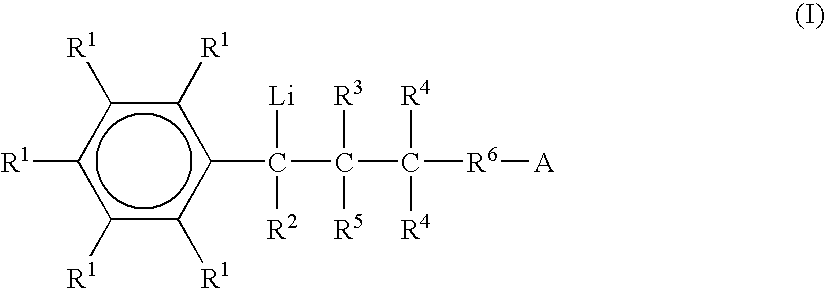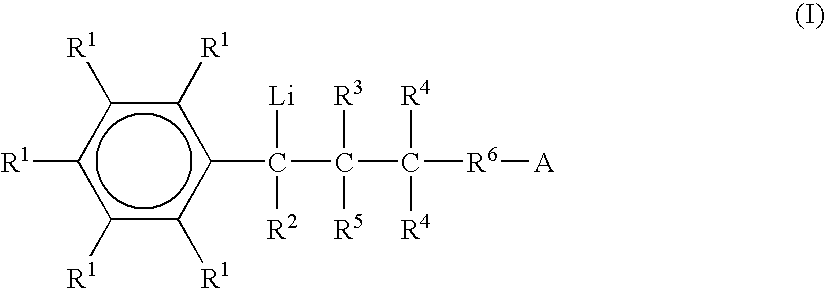Preparation of functionalized anionic polymerization initiators
a technology of anionic polymerization and initiator, which is applied in chemical/physical processes, group 5/15 element organic compounds, sulfur dyes, etc., can solve the problems of reduced head functionality, inefficient preparation of these cyclic aminoalkyllithium compounds, and difficult separation of these products, so as to achieve high-stabilized carbon-lithium sites
- Summary
- Abstract
- Description
- Claims
- Application Information
AI Technical Summary
Benefits of technology
Problems solved by technology
Method used
Image
Examples
example 1
Preparation of Cinnamyl-HMI
[0066] To a solution of hexamethyleneimine (HMI) (31 g, 0.3 mol) in cyclohexane, cinnamyl chloride (22.9 g, 0.15 mol) was added dropwise at room temperature with stirring. After 24 hours of agitation at 65° C., the amine chloride salt was filtered off and the resulting solution (cyclic-amino functionalized styryl compound) concentrated to a dark yellow oil. The product was purified by vacuum distillation (˜1 mm Hg, 80° C.) to yield 22 g (68% yield). The structure was confirmed by 1H NMR analysis.
Preparation of Initiator
[0067] The BuLi-cinnamyl HMI initiator (chain extended) was prepared just prior to polymerization. A small amount of hexanes (61.6 g) was charged to a nitrogen purged reactor. Butyllithium (1.6 M, 8.5 mL) was added followed by cinnamyl-HMI (4.49 M, 2.73 mL) prepared above. Butadiene monomer (21.8% in hexanes, 23.4 g), which was used for chain extension, and a polar modifier (1.6 M, 1.02 mL) were charged last. This mixture was allowed to...
example 2
Preparation of Cinnamyl-O—CH2-pyrene
[0070] To a solution of 1-pyrene methanol (5 g, 21.5 mmol) in THF (150 mL) was added NaH (2 g, 50 mmol). After stirring for 30 min., cinnamyl chloride (4.3 g, 28.7 mmol) was added drop wise. After 2.5 h of reflux, the reaction was quenched with water and the two layers separated. The organic solution was washed with water (2×100 mL), brine (2×100 mL), dried over MgSO4 and concentrated to an orange oil. The product was purified by column chromatography (1:1, CH2Cl2:hexanes) to yield 5 g ( 67% yield). The structure was confirmed by 1H NMR analysis.
In situ Formation of Initiator and Subsequent Polymerization
[0071] The BuLi-Cinnamyl pyrene initiator was prepared in situ. A purged glass reactor (AKA bottle) was prepared in the standard fashion. Hexanes (54.6 g) and butadiene blend (22%, 45.6 g) were charged to the bottle followed by Buli (0.63 mL, 1.68 M) and cinnamyl-pyrene (0.8 mmol). The polar modifier (0.13 mL, 1.6 M) was charged last. This mi...
example 3
Preparation of Cinnamyl-O-tetrahydropyran
[0072] A solution of cinnamyl alcohol (10.6, 19 mmol) and dihydropyran (7.3 g, 87 mmol) in dichloromethane (200 mL) was prepared. A catalytic amount of acid (p-toluene sulfonic acid) (20 mg) was added and the mixture stirred at room temperature under nitrogen for 4 hours. The reaction was diluted with a 5% sodium dicarbonate solution and the two layers separated. The aqueous layer was extracted once with diethyl ether (100 mL). The organic solutions were combined and washed with water (100 mL), brine (100 mL), dried over MgSO4 and concentrated to a yellow oil. The product was pure as evidenced by 1H NMR analysis (16 g: 93% yield).
In situ Formation of Initiator and Subsequent Polymerization
[0073] The BuLi-Cinnamyl-O-tetrahydropyran initiator was prepared in situ. A purged glass reactor (AKA bottle) was prepared in the standard fashion. Hexanes (54.6 g) and butadiene blend (22%, 45.6 g) were charged to the bottle followed by BuLi (0.63 mL,...
PUM
| Property | Measurement | Unit |
|---|---|---|
| Substance count | aaaaa | aaaaa |
| Substance count | aaaaa | aaaaa |
| Substance count | aaaaa | aaaaa |
Abstract
Description
Claims
Application Information
 Login to View More
Login to View More - R&D
- Intellectual Property
- Life Sciences
- Materials
- Tech Scout
- Unparalleled Data Quality
- Higher Quality Content
- 60% Fewer Hallucinations
Browse by: Latest US Patents, China's latest patents, Technical Efficacy Thesaurus, Application Domain, Technology Topic, Popular Technical Reports.
© 2025 PatSnap. All rights reserved.Legal|Privacy policy|Modern Slavery Act Transparency Statement|Sitemap|About US| Contact US: help@patsnap.com



